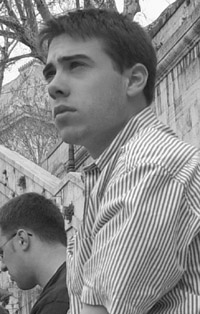 Ben Tooley worked with another student and Professor Schlewitz to study Mexican immigration |
The primary goal of the internship was to find possible answers to the question of why Hispanics are choosing to live and work in Crawfordsville. In order to do this, we studied census data and conducted interviews with Hispanic immigrants and other members of the community.
One such interviewee was a Mexican woman, "Maria," from a small town near Veracruz. Maria came to the United States about two and a half years ago. With the help of a "coyote," she crossed the border illegally at an airport near Douglas, AZ. She took a bus from Tucson to Crawfordsville, her children joining her here much later.
Over the course of the summer, we designed a 15-day research trip to Mexico based upon what we had learned from Maria’s story. In our internship, we attempted to recreate Maria’s journey as best as possible, but do so in reverse by starting our trip in Indiana.
The purposes of our "reverse migration trip" were to investigate the communities sending people to the US, and to experience first hand some of the difficulties involved in such a journey. The one thing we couldn’t recreate was the feeling of leaving everything behind and traveling to an unknown land with the possibility that we might never return home.
Our journey began on a Saturday afternoon at the Greyhound station in Indianapolis. Forty-eight hours and a few too many Greyhound stations later, we arrived in Tucson. From Tucson, we traveled to Douglas on yet another bus. Once in Douglas, we interviewed local officials and several Border Patrol agents. We also visited the airport where Maria crossed into the United States.
After several days in Douglas, we crossed the border to Mexico on foot and took a taxi to the nearest bus station.
What a difference a fence can make! The Mexican city of Agua Prieta was literally a fence’s width from Douglas, yet the differences between the two towns were shocking to a first-time visitor to Mexico like myself. The streets were dusty and many were unpaved and some of the buildings looked as though they were ready to fall down
Slightly less than 30 hours of bus travel later, we were in Guadalajara, where we conducted research and interviews, then made the 15-hour trek to our primary destination, Veracruz.
Maria’s hometown, Vega de Alatorre, was approximately two hours away from Veracruz by car. The town, like many in Mexico, was dingy and quiet; a stark contrast to the surprisingly colorful and lively city of Veracruz. With the help of the local residents, we soon managed to find the home of Maria’s parents, who live on a rocky, dirt road on the outskirts of town. There, we met and spoke with Maria’s mother, who told us that all of their children are now in the United States.
With the money sent to them by their children, Maria’s parents were able to build a cozy two-story house with furniture, concrete floors, and modern conveniences like a telephone, a television, and even a VCR. However, the two-room adobe house where Maria grew up still stands in the backyard serves as a reminder of the impoverished days of the past.
Maria left her town because of a lack of economic and educational opportunities. She came to the United States so that her family could live a better life and so that her children could have opportunities that she never had. She came to Crawfordsville because she knew others who had settled here and had found work.
In a town near Vega de Alatorre, we spoke to Maria’s 24 year-old brother-in-law, whom I will refer to as "Juan." Juan has two older brothers who live and work in Crawfordsville but, for now he will stay in Mexico because he has a steady job. If he does eventually leave Mexico, he said that he would come to Crawfordsville.
Juan and Maria’s reasons for coming here seem to be representative of many of the Hispanic immigrants who have come to Crawfordsville who come to Crawfordsville because of the social networks established by those who came before them. They often stay here because they find work, education for their children, an established Hispanic community, and a new life all their own.
It is true that there are broad social and economic patterns that cause immigrants to come to the United States. However, it is important to keep in mind that each immigrant has his or her own individual reasons for leaving their former life behind to start a new life in the United States. It is also important to remember that the vast majority of immigrants have no ill intentions; their only hope is to live a better life.
Our community needs a deeper understanding Hispanic residents, where they came from, why they came, and what they have to offer the community. Our research internship was a good first step.
Ben Tooley is a Wabash College junior from Berne, Indiana.